A Polarization-Dependent Frequency-Selective Metamaterial Absorber with Multiple Absorption Peaks
Abstract
:1. Introduction
2. Structure and Design
3. Simulated Results and Discussion
4. MA Absorption Dependence on the Wave Incident Angle and Polarization
5. Experimental Results
6. Conclusions
Supplementary Files
Supplementary File 1Acknowledgments
Author Contributions
Conflicts of Interest
References
- Smith, D.; Pendry, J.; Wiltshire, M. Metamaterials and negative refractive index. Science 2004, 305, 788–792. [Google Scholar] [CrossRef] [PubMed]
- Chen, H.T.; Padilla, W.J.; Zide, J.M.; Gossard, A.C.; Taylor, A.J.; Averitt, R.D. Active terahertz metamaterial devices. Nature 2006, 444, 597–600. [Google Scholar] [CrossRef] [PubMed]
- Poddubny, A.; Iorsh, I.; Belov, P.; Kivshar, Y. Hyperbolic Metamaterials. Nat. Photonics 2013, 7, 948–957. [Google Scholar] [CrossRef]
- Chen, H.S.; Wu, B.I.; Zhang, B.; Kong, J.A. Electromagnetic wave interactions with a metamaterial cloak. Phys. Rev. Lett. 2007, 99, 063903. [Google Scholar] [CrossRef] [PubMed]
- Valentine, J.; Zhang, S.; Zentgraf, T.; Ulin-Avila, E.; Genov, D.A.; Bartal, G.; Zhang, X. Three-dimensional optical metamaterial with a negative refractive index. Nature 2008, 455, 376–379. [Google Scholar] [CrossRef] [PubMed]
- Kaina, N.; Lemoult, F.; Fink, M.; Lerosey, G. Negative refractive index and acoustic superlens from multiple scattering in single negative metamaterials. Nature 2015, 525, 77–81. [Google Scholar] [CrossRef] [PubMed]
- Landy, N.; Sajuyigbe, S.; Mock, J.; Smith, D.; Padilla, W. Perfect metamaterial absorber. Phys. Rev. Lett. 2008, 100, 207402. [Google Scholar] [CrossRef] [PubMed]
- Yin, S.; Zhu, J.F.; Xu, W.D.; Jiang, W.; Yuan, J.; Yin, G.; Xie, L.J.; Ying, Y.B.; Ma, Y.G. High-performance terahertz wave absorbers made of silicon-based metamaterials. Appl. Phys. Lett. 2015, 107, 073903. [Google Scholar] [CrossRef]
- Huang, L.; Chowdhury, D.R.; Ramani, S.; Reiten, M.T.; Luo, S.N.; Taylor, A.J.; Chen, H.T. Experimental demonstration of terahertz metamaterial absorbers with a broad and flat high absorption band. Opt. Lett. 2012, 37, 154–156. [Google Scholar] [CrossRef] [PubMed]
- Shi, C.; Zang, X.F.; Wang, Y.Q.; Chen, L.; Cai, B.; Zhu, Y.M. A polarization-independent broadband terahertz absorber. Appl. Phy. Lett. 2014, 105, 031104. [Google Scholar] [CrossRef]
- Zhu, W.R.; Huang, Y.J.; Rukhlenko, I.D.; Wen, G.J.; Premaratne, M. Configurable metamaterial absorber with pseudo wideband spectrum. Opt. Express 2012, 20, 6612–6621. [Google Scholar] [CrossRef] [PubMed]
- Wang, B.X.; Zhai, X.; Wang, G.Z.; Huang, W.Q.; Wang, L.L. Design of a Four-Band and Polarization-Insensitive Terahertz Metamaterial Absorber. IEEE Photonics J. 2015, 7, 4600108. [Google Scholar] [CrossRef]
- Faraji, M.; Morawej-Farshi, M.K.; Yousefi, L. Tunable THz perfect absorber using graphene-based metamaterials. Opt. Commun. 2015, 355, 352–355. [Google Scholar] [CrossRef]
- Zhu, J.F.; Ma, Z.F.; Sun, W.J.; Ding, F.; He, Q.; Zhou, L.; Ma, Y.G. Ultra-broadband terahertz metamaterial absorber. Appl. Phys. Lett. 2014, 105, 021102. [Google Scholar] [CrossRef]
- He, X.J.; Yan, S.T.; Ma, Q.X.; Zhang, Q.F.; Jia, P.; Wu, F.M.; Jiang, J.X. Broadband and polarization-insensitive terahertz absorber based on multilayer metamaterial. Opt. Commun. 2015, 340, 44–49. [Google Scholar] [CrossRef]
- Shrekenhamer, D.; Chen, W.C.; Padilla, W.J. Liquid Crystal Tunable Metamaterial Absorber. Phys. Rev. Lett. 2013, 110, 177403. [Google Scholar] [CrossRef] [PubMed]
- Zhang, Y.; Feng, Y.; Zhu, B. Graphene based tunable metamaterial absorber and polarization modulation in terahertz frequency. Opt. Express 2014, 22, 22743–22752. [Google Scholar] [CrossRef] [PubMed]
- Yahiaoui, R.; Guillet, J.P.; de Miollis, F.; Mounaix, P. Ultra-flexible multiband terahertz metamaterial absorber for conformal geometry applications. Opt. Lett. 2013, 38, 4988–4990. [Google Scholar] [CrossRef] [PubMed]
- Yahiaoui, R.; Tan, S.Y.; Cong, L.Q.; Singh, R.; Yan, F.P.; Zhang, W.L. Multispectral terahertz sensing with highly flexible ultrathin metamaterial absorber. J. Appl. Phys. 2015, 118, 083103. [Google Scholar] [CrossRef]
- Yahiaoui, R.; Hanai, K.; Takano, K.; Nishida, T.; Miyamaru, F.; Nakajima, M.; Hangyo, M. Trapping waves with terahertz metamaterial absorber based on isotropic Mie resonators. Opt. Lett. 2015, 40, 3197–3200. [Google Scholar] [CrossRef] [PubMed]
- Singh, P.K.; Korolev, K.A.; Afsar, M.N.; Sonkusale, S. Single and dual band 77/95/110 GHz metamaterial absorbers on flexible polyimide substrate. Appl. Phys. Lett. 2011, 99, 264101. [Google Scholar] [CrossRef]
- Zhou, W.; Wang, P.; Wang, N.; Jiang, W.; Dong, X.; Hu, S. Microwave metamaterial absorber based on multiple square ring structures. AIP Adv. 2015, 5, 117109. [Google Scholar] [CrossRef]
- Hokmabadi, M.P.; Wilbert, D.S.; Kung, P.; Kim, S.M. Polarization-Dependent, Frequency-Selective THz Stereometamaterial Perfect Absorber. Phys. Rev. Appl. 2014, 1, 044003. [Google Scholar] [CrossRef]
- Hu, F.R.; Zou, T.B.; Quan, B.G.; Xu, X.L.; Bo, S.H.; Chen, T.; Wang, L.; Gu, C.Z.; Li, J.J. Polarization-dependent terahertz metamaterial absorber with high absorption in two orthogonal directions. Opt. Commun. 2015, 332, 321–326. [Google Scholar] [CrossRef]
- Wang, B.X.; Wang, G.Z.; Sang, T. Simple design of novel triple-band terahertz metamaterial absorber for sensing application. J. Phys. D Appl. Phys. 2016, 49, 165307. [Google Scholar] [CrossRef]
- Mao, Z.W.; Liu, S.B.; Bian, B.R.; Wang, B.Y.; Ma, B.; Chen, L.; Xu, J.Y. Multi-band polarization-insensitive metamaterial absorber based on Chinese ancient coin-shaped structures. J. Appl. Phys. 2014, 115, 204505. [Google Scholar] [CrossRef]
- Arezoomanda, A.S.; Zarrabib, F.B.; Heydaria, S.; Gandjic, N.P. Independent polarization and multi-band THz absorber base on Jerusalem cross. Opt. Commun. 2015, 352, 121–126. [Google Scholar] [CrossRef]
- Bhattacharyya, S.; Ghosh, S.; Srivastava, K.V. Triple band polarization-independent metamaterial absorber with bandwidth enhancement at X-band. J. Appl. Phys. 2013, 114, 094514. [Google Scholar] [CrossRef]
- Hu, F.R.; Wang, L.; Quan, B.G.; Xu, X.L.; Li, Z.; Wu, Z.A.; Pan, X.C. Design of a polarization insensitive multiband terahertz metamaterial absorber. J. Phys. D Appl. Phys. 2013, 46, 195103. [Google Scholar] [CrossRef]
- Álvarez, H.F.; Gómez, M.E.; Las-Heras, F. Angular stability of metasurfaces: Challenges regarding reflectivity measurements. IEEE Antennas Propag. Mag. 2016, 58, 74–81. [Google Scholar] [CrossRef]

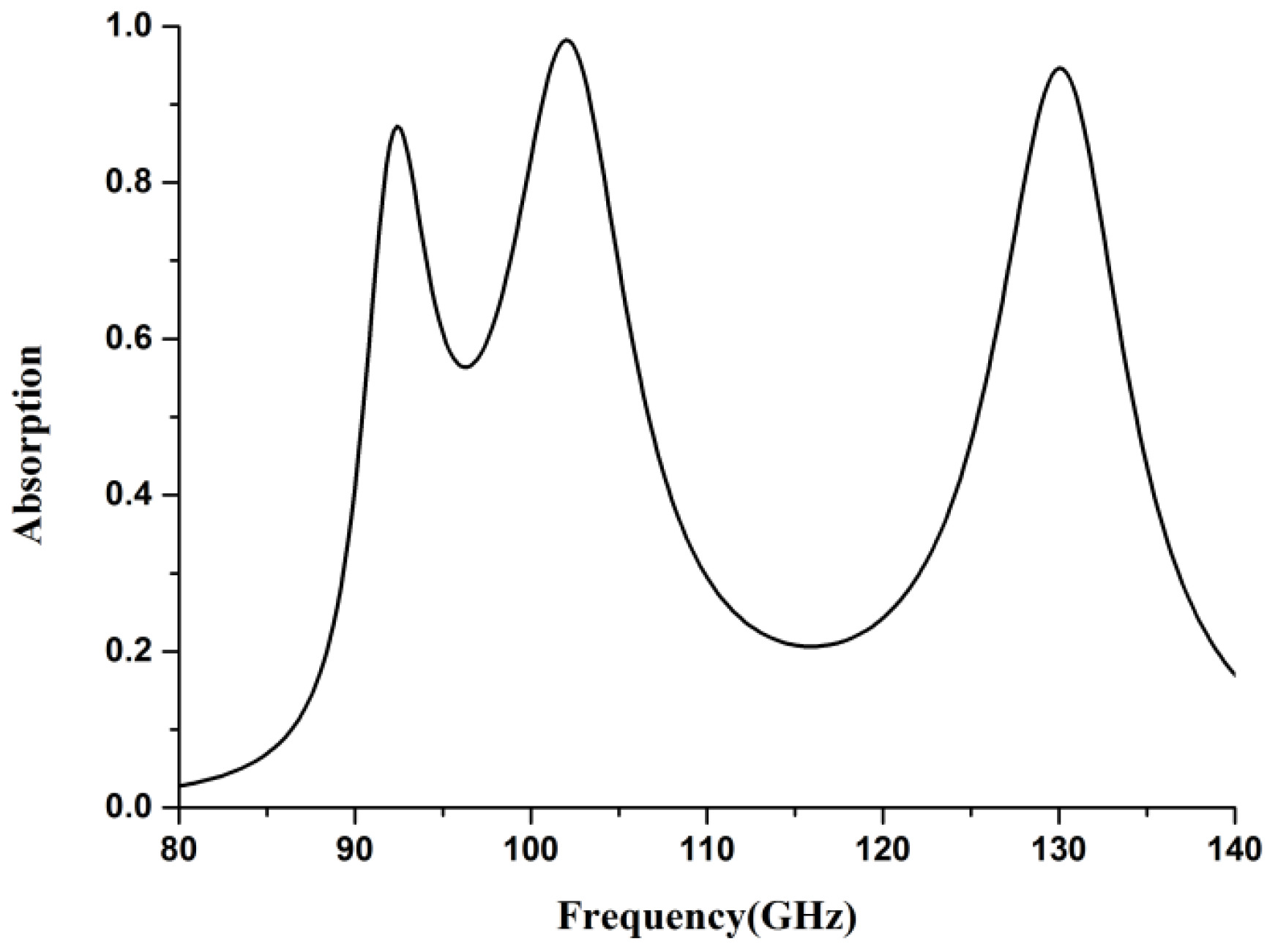
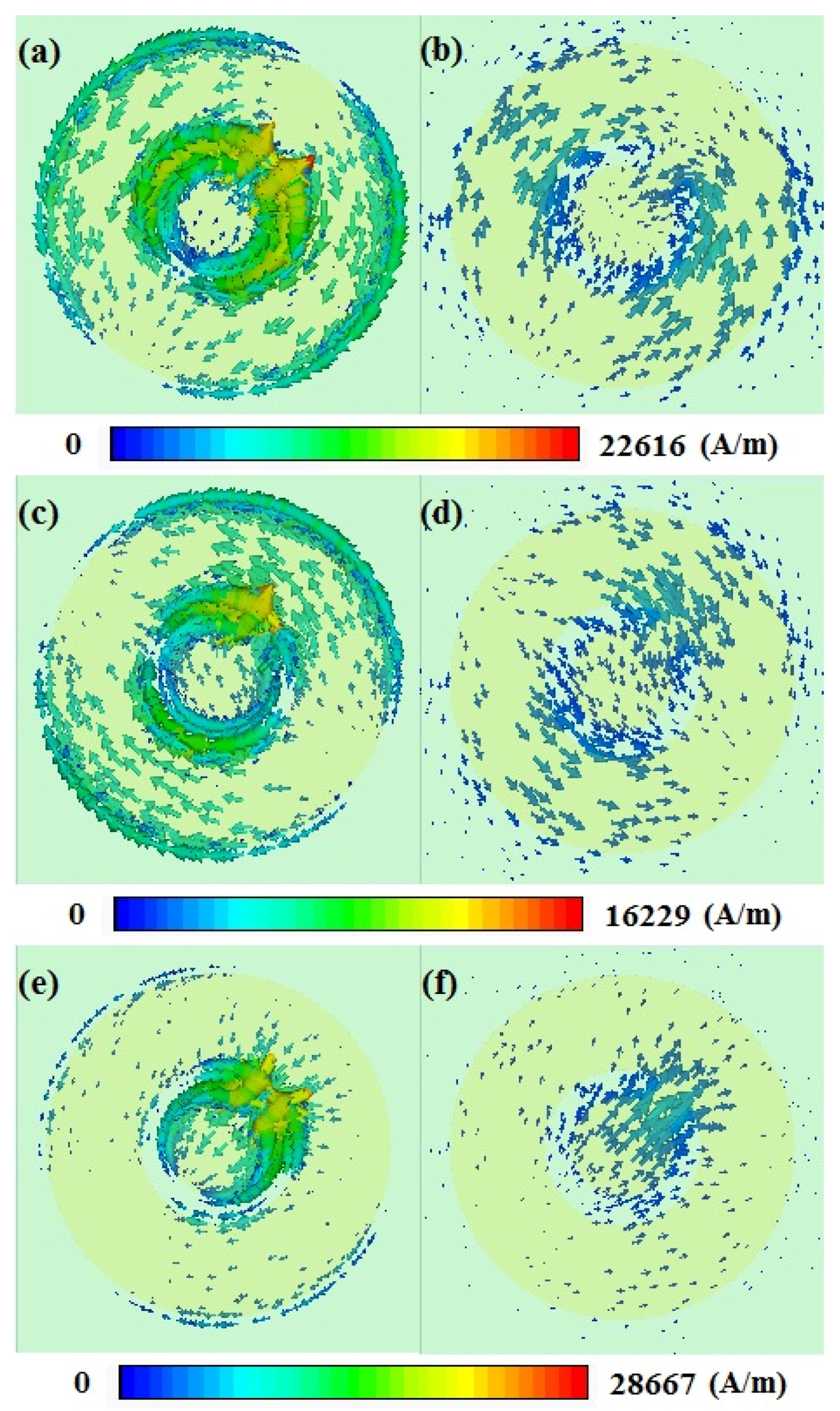
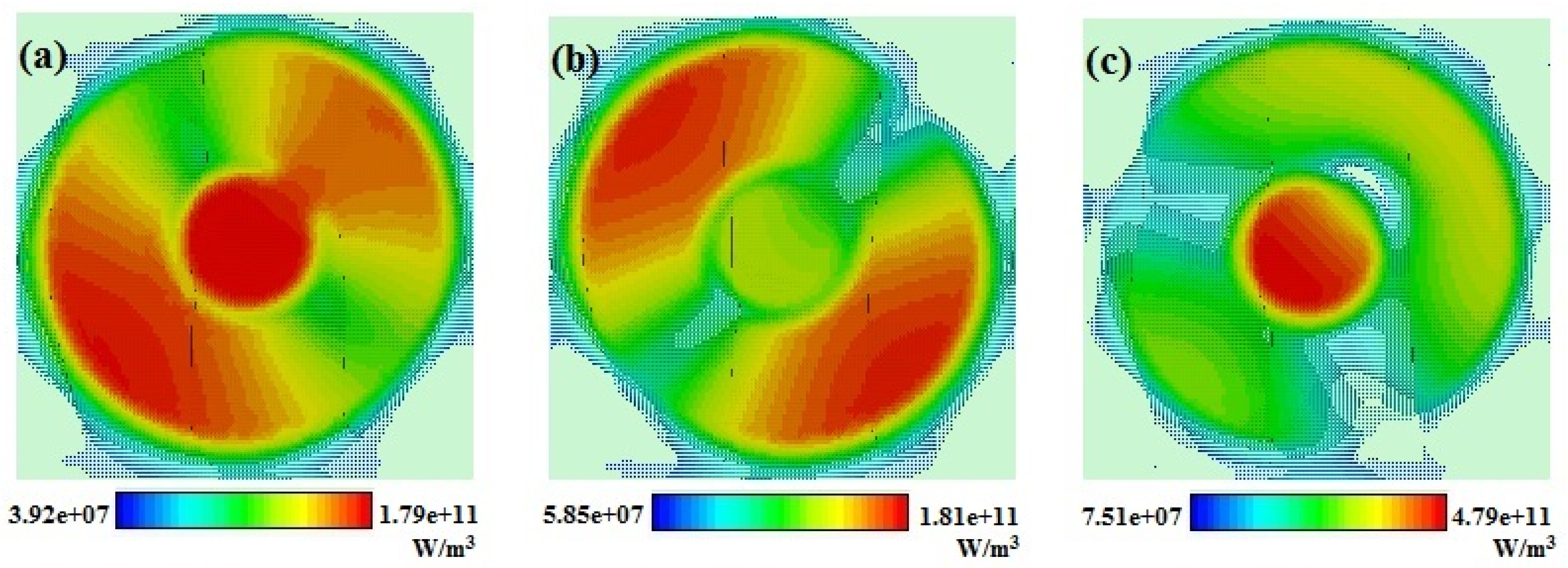


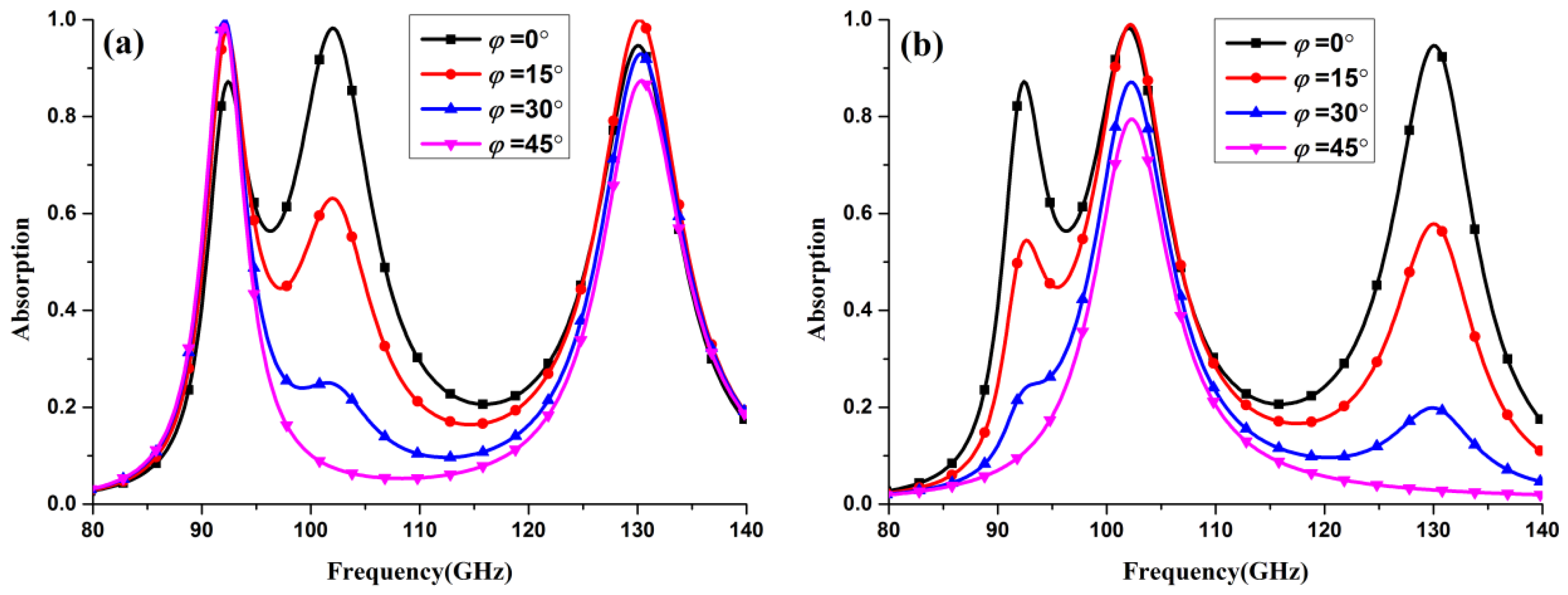
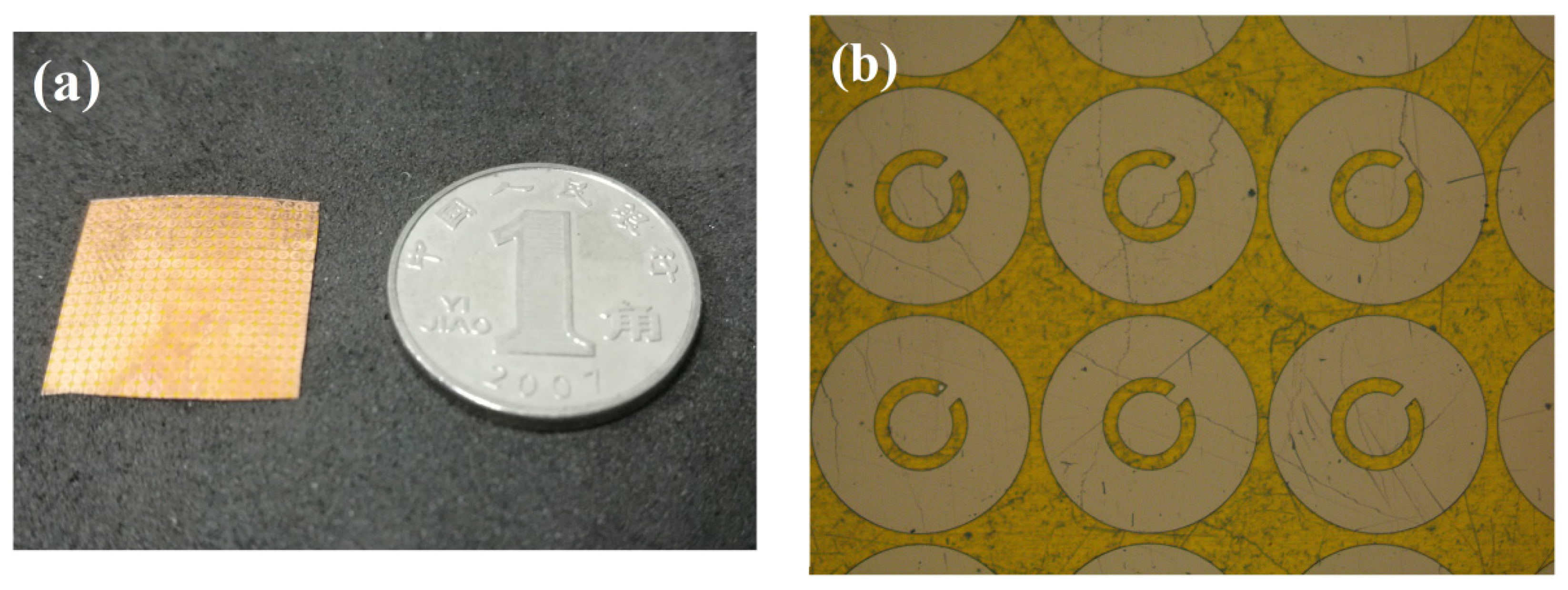
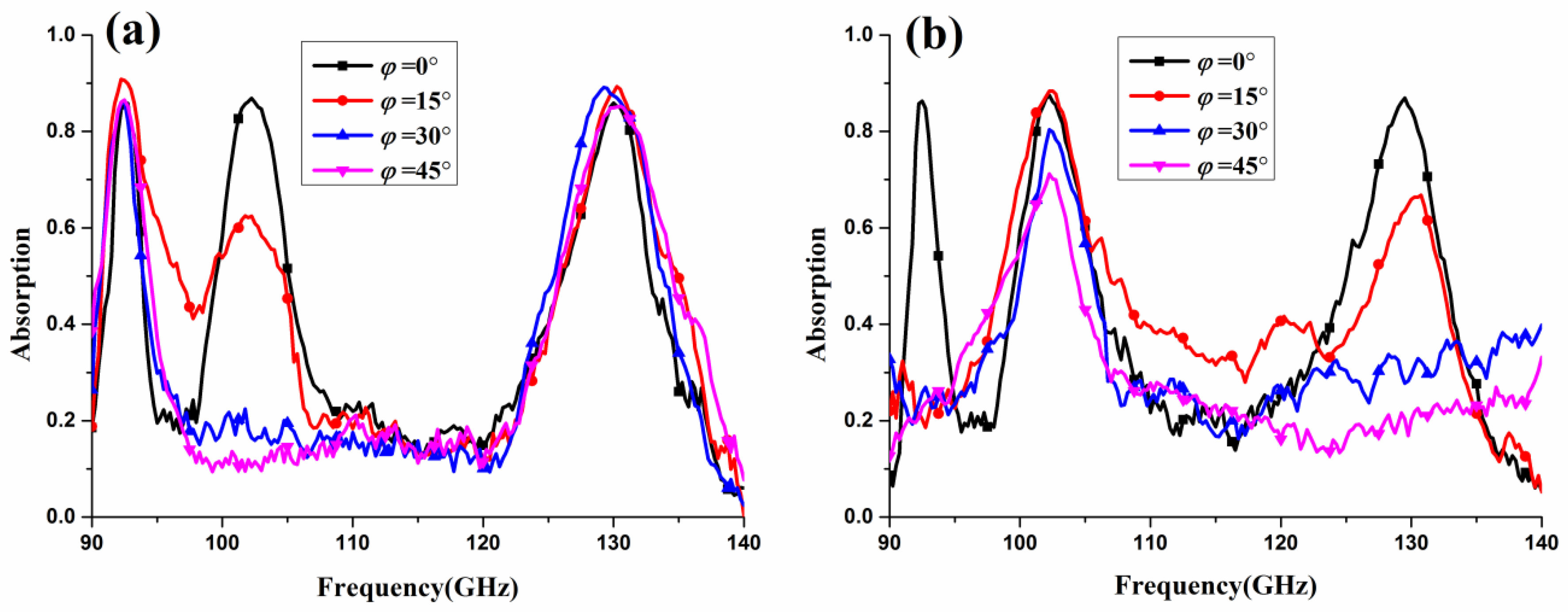
© 2017 by the authors. Licensee MDPI, Basel, Switzerland. This article is an open access article distributed under the terms and conditions of the Creative Commons Attribution (CC BY) license (http://creativecommons.org/licenses/by/4.0/).
Share and Cite
Deng, G.; Xia, T.; Fang, Y.; Yang, J.; Yin, Z. A Polarization-Dependent Frequency-Selective Metamaterial Absorber with Multiple Absorption Peaks. Appl. Sci. 2017, 7, 580. https://doi.org/10.3390/app7060580
Deng G, Xia T, Fang Y, Yang J, Yin Z. A Polarization-Dependent Frequency-Selective Metamaterial Absorber with Multiple Absorption Peaks. Applied Sciences. 2017; 7(6):580. https://doi.org/10.3390/app7060580
Chicago/Turabian StyleDeng, Guangsheng, Tianyu Xia, Yong Fang, Jun Yang, and Zhiping Yin. 2017. "A Polarization-Dependent Frequency-Selective Metamaterial Absorber with Multiple Absorption Peaks" Applied Sciences 7, no. 6: 580. https://doi.org/10.3390/app7060580






